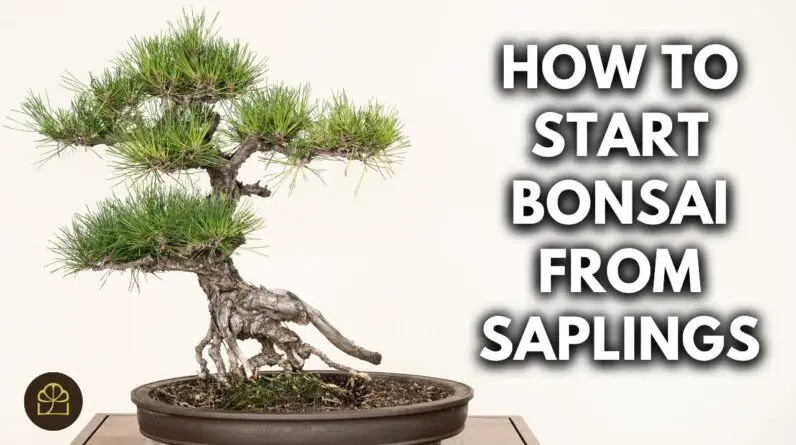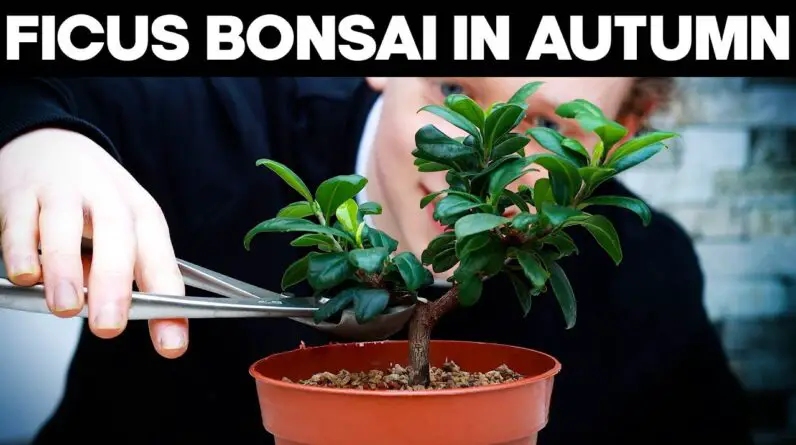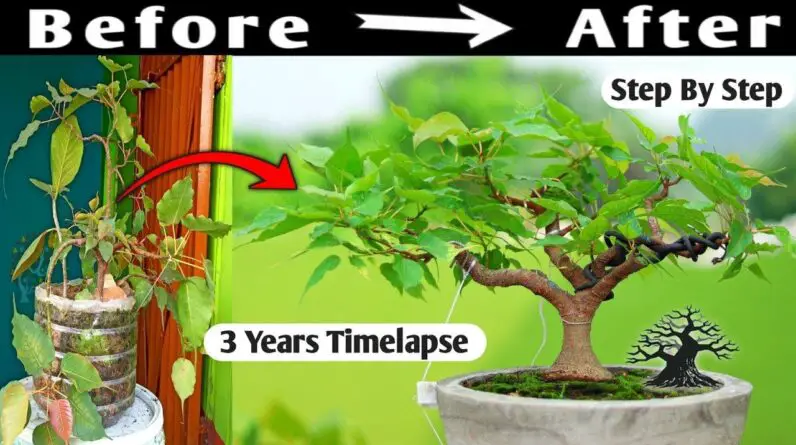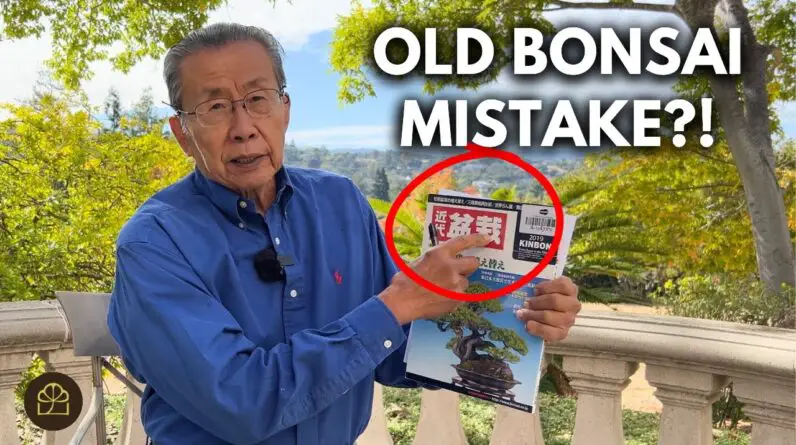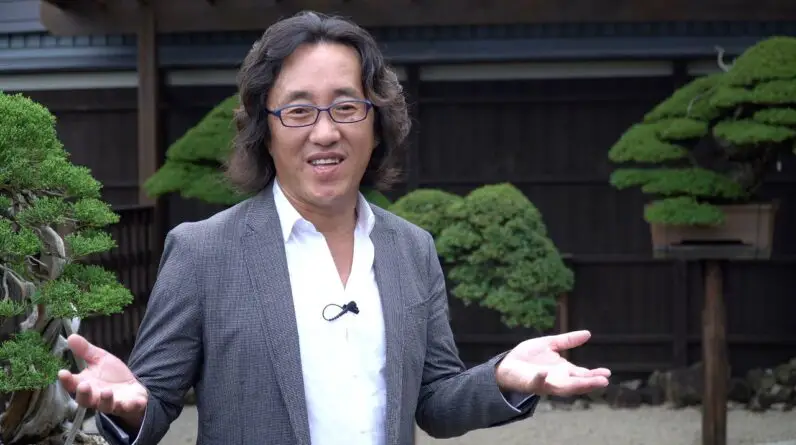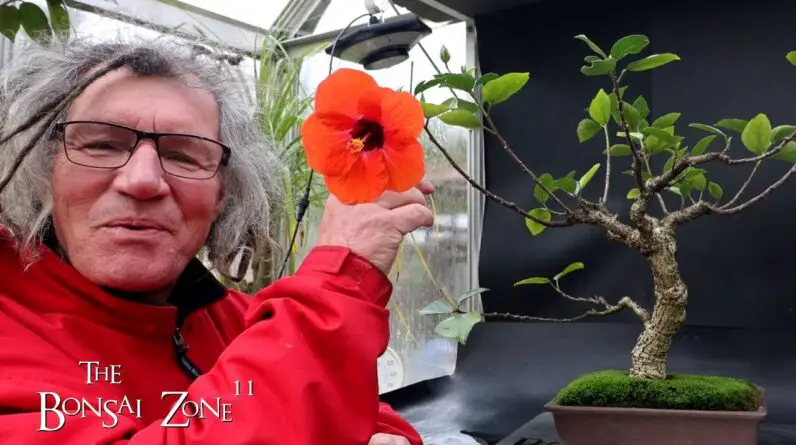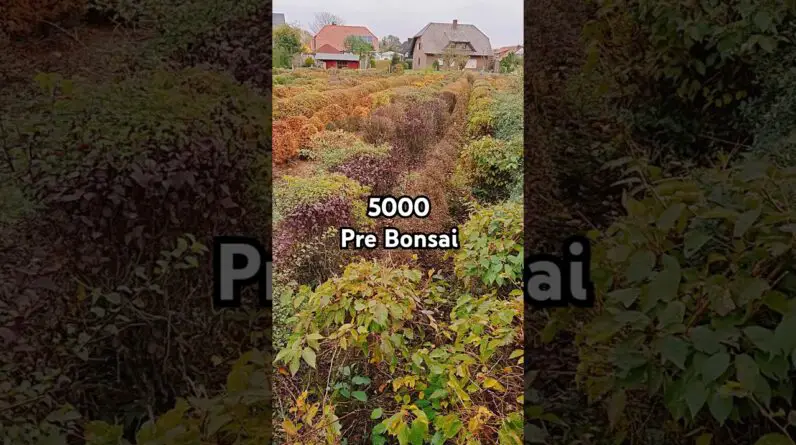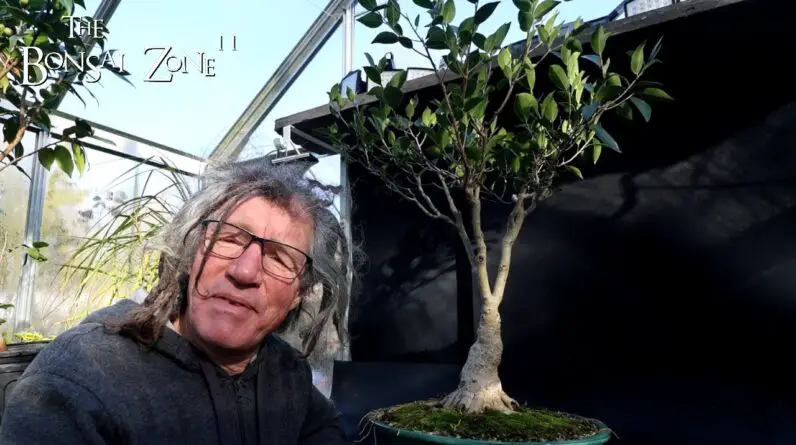Want to find out how to make an Apple bonsai tree? In this video clip by Bonsai Empire, they reveal you exactly how to prune and wire an Apple tree that is around 15 years of ages. The video clip was filmed throughout fall, when the tree was loaded with little apple trees.
Bonsai Empire is passionate regarding sharing the living art of Bonsai and developed this do it yourself tutorial to help and influence beginners. This video belongs to their on the internet programs, however they use many other cost-free video clips as well.
So if you have an interest in learning more about Bonsai methods, head over to Bonsai Realm’s internet site!
In the video clip, they explain the procedure of pruning and wiring this Apple bonsai tree. They make use of small trimming shears, pliers, and cable cutters. The top branch is the very first to be cut, and after that they concentrate on two thicker branches to attain the wanted silhouette.
They show the significance of a 360-degree technique when trimming and wiring to stay clear of any dead angles. After the pruning and circuitry, the tree looks much more refined and balanced. With normal upkeep, this tree will certainly continue to flourish and grow new branches in the upcoming spring. If you wish to find out more regarding trimming, circuitry, and repotting strategies, take into consideration signing up with Bonsai Realm’s on the internet courses and access to professional assistance and the possibility to ask the instructors questions straight.
Apple Bonsai Tree: An Introduction
Invite to the globe of apple bonsai trees! Developing and growing a small apple tree can be a rewarding and satisfying pastime. Not only do these bonsai trees offer a beautiful visual, however they also supply the possibility to expand your own fruits in a small and workable room.
In this thorough post, we will certainly lead you through the procedure of picking the appropriate apple tree selection, collecting the essential materials, expanding the tree from seeds, pruning and electrical wiring techniques, correct upkeep, potting factors to consider, and the differences between outside and interior apple bonsai trees.
Think about the Dimension of the Bonsai
When selecting an apple tree selection for bonsai farming, it is essential to think about the ultimate dimension of the tree. Considering that bonsai trees are implied to be miniature variations of their larger equivalents, choosing a selection that normally remains tiny is essential. Try to find apple tree varieties that are recognized for their small development and smaller stature, such as columnar apple trees or naturally dwarf selections. This will guarantee that your bonsai continues to be symmetrical and is easier to take care of.
Pick a Crab Apple Tree Range
Crab apple trees, with their small and vibrant fruits, are typically the preferred choice for apple bonsai farming. These trees naturally have much more fragile and proportional functions, making them well-suited for bonsai visual appeal. Additionally, crab apple trees are sturdy and adaptable, making them easier to care for and preserve as bonsai specimens. Consider varieties such as Malus sylvestris or Malus floribunda, which are frequently utilized in bonsai growing.
Consider the Environment and Place
Before selecting the apple tree selection for your bonsai, it is very important to take into consideration the climate and area where you prepare to grow it. Various apple tree ranges thrive in different climates, so pick a selection that is fit to your details area. Additionally, keep in mind the amount of sunlight and temperature demands of the selected variety. Many apple trees call for complete sunlight to grow, so guarantee that your picked place offers enough sunlight throughout the day.
Select an Appropriate Bonsai Pot
Selecting the right bonsai pot is critical for the health and wellness and aesthetic appeals of your apple bonsai tree. Seek a pot that is in proportion to the dimension of your tree and matches its overall design. Bonsai pots are available in different products such as ceramic, plastic, or clay. Each material has its own benefits and considerations, so select one that matches your personal preferences and the details needs of your apple bonsai tree.
Obtain High Quality Bonsai Dirt
Top notch bonsai dirt is necessary for the healthy and balanced development of your apple bonsai tree. The dirt needs to offer appropriate drain while keeping adequate dampness for the tree’s roots. You can purchase pre-made bonsai dirt mixes that are specifically made for bonsai growing, or you can produce your very own mix by integrating parts such as Akadama, pumice, and lava rock. Trial and error with different soil mixtures might be needed to locate the excellent balance for your apple bonsai tree.
Obtain Trimming and Wiring Tools
Trimming and circuitry are important techniques for shaping and maintaining the form of your apple bonsai tree. To effectively trim and wire your bonsai, you will certainly need a set of proper devices. Some necessary devices include a scooped branch cutter for precise pruning, bonsai wire cutters for handling the cable, and pliers or tweezers for elaborate work. Purchase top quality devices to ensure accuracy and minimize damages to your apple bonsai tree.
Gathering Apple Seeds
One of the most rewarding means to start an apple bonsai tree is by expanding it from seeds. You can collect apple seeds from ripe fruits or buy them from reputable suppliers. Make certain that the seeds are fresh and sensible for the very best chances of germination.
Prep work of Seeds for Planting
Before growing the apple seeds, it’s important to prepare them for ideal germination. Begin by soaking the seeds in water for 24 hours to soften the outer seed layer. After saturating, eliminate the seeds from the water and allow them to completely dry for a few days. This procedure helps break the seed’s inactivity and increases the opportunities of successful germination.
Planting and Germination Refine
When the seeds are prepared, plant them in little pots loaded with well-draining bonsai soil. Place the pots in a warm and bright area, and maintain the dirt constantly wet. Germination generally takes around two to four weeks, depending on the range and ecological problems. When the seedlings have sprouted, select the healthiest ones to continue growing as your future apple bonsai trees.
Comprehending Pruning Methods
Trimming is a critical facet of bonsai growing that helps keep the tree’s dimension, form, and overall visual appeals. By selectively eliminating branches and vegetation, you can achieve the wanted type and equilibrium. Find out about different pruning strategies such as upkeep trimming, branch pruning, and pinching to maintain the health and wellness and form of your apple bonsai tree.
Identifying the Right Branches to Prune
When trimming your apple bonsai tree, it is very important to recognize the branches that need to be pruned. Search for branches that interrupt the desired form or prevent the tree’s general balance. Remove any kind of dead, harmed, or unwanted branches to advertise healthy development and avoid disease. Seek advice from bonsai sources or seek guidance from experienced bonsai fanatics if you’re unsure which branches to prune.
Pruning to Attain Desired Forming
Trimming is not just about upkeep however additionally concerning shaping your apple bonsai tree. Use pruning strategies to guide the tree’s development and attain the wanted form and style. Take into consideration traditional bonsai forms such as formal upright, inclining, or waterfall, and adjust them to fit the features of your apple bonsai tree.
Preparing the Tree for Electrical wiring
Wiring is one more vital method in bonsai cultivation that assists produce and keep the preferred form and framework of your apple bonsai tree. Prior to applying wires, guarantee that the branches and trunk are adaptable adequate to be controlled without causing damage. Younger branches are a lot more flexible and less complicated to wire, while older branches may call for steady flexing with time.
Choosing the Right Cable Size
Choosing the suitable cable size is vital to avoid harming the branches of your apple bonsai tree. The cord must be strong sufficient to hold the desired shape without cutting into the bark. Select a cable dimension that is around one-third of the density of the branch being wired. Copper or light weight aluminum cable is generally used, however make sure it is soft sufficient to be conveniently shaped.
Using Circuitry Strategies
To wire your apple bonsai tree, start by covering the wire at the base of the branch or trunk and then carefully spiral it upwards, ensuring to preserve a 45-degree angle in between the cord and the branch. Take care not to wrap the cord also firmly, as it can restrict the tree’s circulation and cause damage. Once the preferred form is attained, secure the cord by twisting the ends with each other or using cord clips. Get rid of the cable after a couple of months to prevent it from cutting into the bark.
Watering and Moisture Control
Appropriate watering is crucial for the health and vitality of your apple bonsai tree. The frequency and quantity of water needed depend on different elements such as the climate, pot dimension, and tree’s development stage. Water your apple bonsai tree when the leading inch of soil feels completely dry, making sure that the water gets to the whole origin system. Prevent overwatering, as it can bring about root rot and various other fungal illness.
Feeding and Nutrient Demands
Preserving dirt fertility is vital for the healthy growth of your apple bonsai tree. Apply a well balanced fertilizer throughout the expanding season to offer the essential nutrients for optimum development. Use natural or slow-release fertilizers particularly formulated for bonsai trees, complying with the recommended dosage instructions. Consistently keep an eye on the tree’s response to fertilizing and readjust the feeding routine as necessary.
Bug and Illness Administration
Like any other plant, apple bonsai trees can be prone to different bugs and conditions. Routinely examine your tree for indicators of infestation, such as discolored leaves, bugs, or unusual development. If any kind of issues are detected, quickly take suitable steps to regulate and remove the problem. Take into consideration making use of natural insect control techniques or talk to specialists if essential.
Repotting Regularity and Timing
Repotting is an essential job in bonsai farming that permits root system wellness and general growth control. The frequency and timing of repotting depend on numerous variables such as the age and growth price of the apple bonsai tree. As a general standard, repotting is typically done every two to three years, ideally throughout the very early springtime prior to the tree begins actively growing.
Choosing an Appropriate Bonsai Pot
When repotting your apple bonsai tree, select a new pot that is somewhat larger than the existing one. Consider the aesthetic appeals and general equilibrium of the tree when selecting the pot’s shape and design. Make sure that the pot supplies sufficient drainage openings and is made from a material that appropriates for bonsai farming.
Hair Transplanting and Root Pruning
During repotting, carefully eliminate the tree from its present pot and delicately loosen up the origin sphere. Check the roots and cut any kind of damaged or excessively long origins. This procedure, called origin trimming, assists promote new root growth and maintains the tree’s origin system portable. After origin trimming, place the tree in the brand-new pot, ensuring that the origins are uniformly distributed and covered with fresh bonsai soil.
Proper Potting Strategies
When potting your apple bonsai tree, usage appropriate techniques to guarantee its security and healthy and balanced development. Position the tree a little off-center in the pot to develop a sense of motion and equilibrium. Protect the tree in place utilizing bonsai cords or rocks, and fill up the remaining area in the pot with bonsai soil, making sure that no air pockets are left. Water the newly potted tree extensively and monitor its healing throughout the adhering to weeks.
Advantages and Considerations for Outdoor Bonsai
Growing an exterior apple bonsai tree permits it to experience the natural transforming seasons, which can enhance its overall beauty. Outdoor bonsai trees generally have more space to grow and develop a stronger root system. However, outdoor bonsai trees require careful consideration of climate and weather conditions, protection from extreme temperature fluctuations, and regular exposure to sunlight.
Benefits and Challenges of Indoor Bonsai
Growing an apple bonsai tree indoors provides more controlled conditions and allows enthusiasts in colder climates to enjoy bonsai cultivation year-round. Indoor bonsai trees require careful attention to temperature, humidity, and lighting conditions. Supplemental lighting may be necessary, especially during the winter months when sunlight exposure is limited. Additionally, indoor bonsai trees may require more vigilant pest and disease management due to the controlled environment.
Creating and caring for an apple bonsai tree is a rewarding and fulfilling endeavor. With proper knowledge and techniques, you can enjoy the beauty of nature in a miniature form and even grow your own miniature apples.
By choosing the right variety, gathering the necessary materials, mastering pruning and wiring techniques, maintaining proper care, and selecting the right pot and location, you can cultivate a stunning apple bonsai tree that brings joy and tranquility to your surroundings.
Happy bonsai cultivation!
[sspostsincat category=”Can Fruit Trees Be Bonsai Trees?”]


